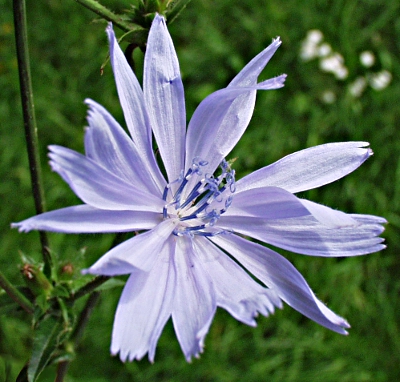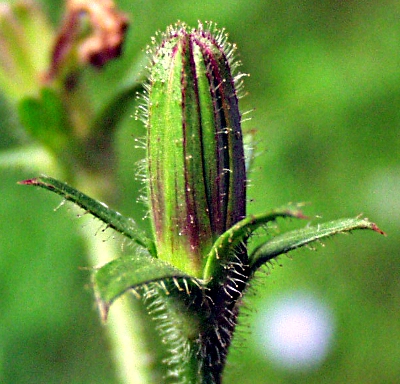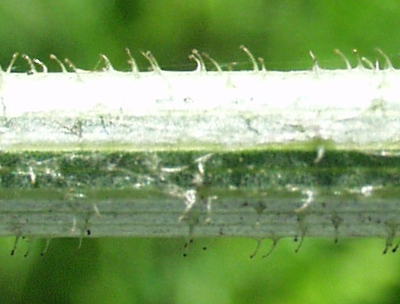Wild chicory |




Flower head, bud, leaf and stem of the wild chicory
| Cichorium intybus L.: | |
| Blooming period: | July–Oktober |
| Height: | 40–110 cm |
| Flowers: | in heads, Ø of the heads 25–45 mm, stamens: 5, styles: 1 |
| Ray florets: | pale to bright blue |
| Disc florets: | missing |
| Calyx: | transformed into scales |
| Stem leaves: | sessile, alternate, entire to runcinate |
| Basal leaves: | mostly runcinate |
Plant perennial, herbaceous, with a long and strong taproot.
Stem erect, hollow,
grooved,
wiry, glabrous or glandular-hispid, squarrose branched.
Basal
leaves rosulate, narrowing into a short stalk,
often pinnatifid,
rarely only toothed, sparsely and long hairy, dandelion-like.
Stem leaves decreasing upwards in size, sessile up to half stem clasping, acute, linear, entire, toothed or pinnatifid, margins with short bristles.
Flower heads solitary at the top of lateral branches and solitary or in small groups in the axils of leaves and branches. The receptacle is flat and pitted.
The phyllaries are sparsely covered with simple or glandular hairs, pointed, lance-shaped, more or less strongly keeled and arranged in 2 rows. The outer ones (usually 5–6) are bent back or upright, often shorter than the inner ones and ciliated at the margins. The inner phyllaries (about 8) are usually longer (6–12 mm) and non-ciliated. Involucre initially cylindrically, 5–20 mm long.
The flower head exclusively consists of 15–20 ray florets, which are blue or rarely white to pink, hermaphrodite, about 20 mm long, 5-dentate and with blue anthers and stigmas. The 3–5 mm long anthers are connate at their margins and let the tube often appear striped blue and white. Flowers at the base without chaffy leaves.
After pollination by bees or hoverfly or after self-pollination the inferior ovary forms a 2–3 mm long nut fruit (achene), which is cylindrical to oblong, ribbed and slightly wrinkled. At the apex it has 1–3 rows of short, blunt scales, developed out of the calyx.
| Floral formula: |
| ↓ K=scales [C(5) A5(connate)] G(2) inferior |
Occurrence:
An Weg- und Feldrändern, Bahngleisen. Bevorzugt helle und leicht warme
Standorte und basische, stickstoffreiche Böden.
Distribution:
Originally
Europe and Asia, introduced in Africa and the Americas.